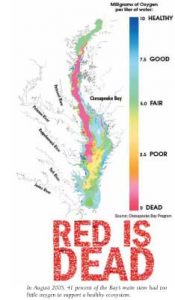The term “Dead Zone” was coined in the Gulf of Mexico when it was recognized that the nutrient rich discharge from the Mississippi River (again, due to inefficient agricultural fertilization practices and urban discharges) caused the prolific growth of tiny floating plants (phytoplankton.) There aren’t enough animals to consume all the tiny plants, so the plants die, sink to the bottom, and the excess organic material rots (is respired by microbes), consuming oxygen and limiting animal life. Based on sediment cores, Chesapeake Bay has always had a small Dead Zone in the deep central axis of the Bay. But the Dead Zone has expanded so that in summer it now occupies approximately 1/3 of the Bay (www.cbf.org). Not as well publicized is the fact that in mid summer many small creeks become hypoxic (dissolved oxygen less than 5 milligrams per liter, or 5 ppm) or anoxic (dissolved oxygen essentially absent.)
I measure the dissolved oxygen concentration in the Little Wicomico River near the mouth of Spencer’s Creek where the water depth is 7 feet. In mid-summer of 2004, and 2005 and 2006 the water just above the bottom contained less than 1.4 mg/l dissolved oxygen, whereas the surface water was saturated with dissolved oxygen. The water just above the bottom was hypoxic and animal life was impaired. The first clue to the presence of a “Dead Zone” in small waterways is that the crabbers move their pots to the edges of the waterways so that crab pot floats disappear from the channel axis. A crab pot in deep water near the center of the waterway either won’t catch crabs, or the crabs die. Why does this happen in such shallow water?
In the worst case scenario, near mid-summer when the water is warm and is capable of dissolving only small amounts of oxygen gas, there is a rainfall event followed by a period of little wind. The rain creates stratification or layering of the water, with the low salinity, low density water floating on top, acting like wax on the top of a jelly jar. In the absence of wind to destroy the stratification, the saltier (denser) bottom water is isolated and out of contact with the atmosphere. Plants cannot grow and provide oxygen in the bottom water because of the turbidity. Oxygen is removed from the isolated bottom water by the respiration of animals like fish and crabs, but especially by the stinking anoxic muddy sediment that acts like an “oxygen sponge” as microbes respire the organic material in the mud. The oxygen cannot be replenished from the atmosphere, and oxygen concentrations in the bottom water decrease until the water can no longer support animal life. Rotting carcasses add to the problem. Except for microbes that can tolerate oxygen-free conditions, the bottom sediment and the bottom water are truly “Dead.” It is no wonder that the local oyster grounds contain no live oysters. The problem is not oyster disease, because oysters survive in surface floats. The bottom-dwelling oysters cannot live long enough to reach market size because of summer Dead Zones.
Summer dead zones like the one in the Little Wicomico River are in clear violation of the Clean Water Act because the water is not “fishable.” Despite this incontestable fact, little monitoring of small waterways is being done, and next to nothing is being done to correct the problem. The reason for not gathering appropriate data and not acting on existing data is that the cause of the problem, nutrients from agricultural practices, is crystal clear. No State or Federal agency has yet been willing to admit to this fact and then do something about it.

The volume of the dead zone in the axis of Chesapeake Bay, as reported by CBF in their report on the “State of the Bay, 2005,“ is not decreasing. Dead zones are also becoming more common in small tidal waterways connected to the Bay. Reducing agricultural fertilizer pollution by voluntary efforts is not working, and mandated restrictions on fertilization practices, especially the use of animal waste, are necessary.